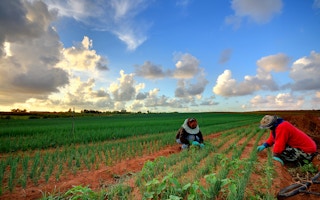Something’s cooking in the Greater Mekong Subregion (GMS), and it promises to be good.
Ten years ago, ministers of agriculture from Cambodia, the People’s Republic of China (PRC), Lao People’s Democratic Republic, Myanmar, Thailand, and Vietnam met to address the challenges faced by smallholder farmers in the subregion.
Little did they know those discussions would yield commitments honoured today that promote greater cooperation among the countries in support of their farmers.
In September 2017, GMS ministers endorsed the Strategy for Promoting Safe and Environment-Friendly Agro-Based Value Chains in the GMS, and Siem Reap Action Plan for 2018-2022. The strategy’s ambitious goal is to transform GMS agriculture systems into leading global suppliers of safe and environment-friendly agriculture products (SEAP).
Opportunity beckons
The vision resonates. It is supported in part by years of stable economic growth, averaging 7.5 per cent per capita since 1992, and an annual urbanisation growth of 3 per cent that together significantly impact the way consumers relate to food.
Farmers in the subregion are changing by adopting climate-smart practices like the application of biochar and organic composts rather than chemical fertilisers. Use of organic fertilisers is environment friendly as it enhances the soil’s health by increasing the soil nutrients, and its capacity to store water and sequester carbon from the atmosphere.
Agribusiness companies that are linked to smallholders are also becoming better at reaching out to regional and global markets. Connectivity to international markets expands the income pathways of small farmers.
Agricultural and food trade in the GMS is growing rapidly, thanks to policy initiatives like the memorandum of understanding between Thailand and Cambodia that promotes contract growing arrangements between their agriculture sectors, including transport corridors and logistics systems. Improved infrastructure and the opportunity to move further along the value-added path are increasing the flow of foreign direct investment (FDI) for GMS agribusinesses.
Increasingly comprehensive supply chains in rice and other agricultural products like coffee, rubber, pepper, cashew nut, dried fruits like durian and jackfruit, and aquaculture have developed in recent years in the subregion. As a result, international trading networks are being linked to more lucrative and discerning markets like Japan, the Republic of Korea, and the European Union (EU).
GMS countries have doubled down on efforts to export more value-added products rather than just raw materials, again leveraged through FDI and joint ventures that have embodied technology and market links.
These factors provide a great opportunity. The subregion is strategically located close to major markets like the PRC, India, and Southeast Asia, which are expanding five-to-10 times faster than the US or the EU. Also, major transport corridors are linking the GMS to Central Asia, South Asia, and Europe.
Urbanisation is likewise having a significant impact on our food systems and our diets. In the GMS and the growing economies adjacent to it, people are placing greater emphasis on food quality, safety, healthiness, variety, and environmental friendliness.
These days, knowing where the trendy restaurants are pales in comparison to knowing where one’s food comes from, and whether meals are produced with utmost regard for the environment and people’s safety. The shift in culinary consciousness is a welcome development that promises greater connectivity between producers, consumers, and the environment where food is sourced.
As the food trade in the GMS expands, more perishable products and livestock cross the porous borders, presenting considerable risks to animals and humans alike. Agribusinesses are under increasing pressure to better manage food safety risks to protect domestic consumers and meet customer requirements.
The existence of an internationally recognised quality infrastructure (a systemic approach to standardisation, testing, certification, and accreditation) is increasingly becoming a prerequisite for participating in international trade, as well as for building consumer trust and confidence in food systems.
Challenges ahead
But the path to green goodness in the GMS is not as smooth as one would expect.
Food safety and quality assurance standards vary greatly across GMS countries. Numerous agencies and stakeholders are involved, many working in silos. Too many smallholder farmers and small and medium-sized enterprises are scattered all over, so product quality is inconsistent and scale cannot be achieved. Other problems that weaken the SEAP value chain link are lack of cold chains, poor access to market information, and inadequate food safety laboratories and experts at the border.
There is much work to be done. The first order of the day for agriculture ministries implementing the Strategy and the Action Plan is to develop harmonised policies that facilitate production, trade, and investment in safe and environmentally friendly agro-based value chains.
“
The shift in culinary consciousness is a welcome development that promises greater connectivity between producers, consumers, and the environment where food is sourced.
The GMS Working Group on Agriculture is collaborating with Food Industry Asia to improve the technical skills of scientists to properly detect mycotoxins and other aflatoxin problems. Cambodia is preparing a policy on a participatory guarantee system (PGS), a credible but less costly accreditation mechanism to certify organic products by smallholder farmers that could be replicated across the GMS.
Investments in infrastructure to support these value chains are likewise in the pipeline, and one of the priority areas focuses on establishing cross-border livestock disease control zones.
A recent study from the PRC province of Yunnan noted that about 1 million livestock cross the porous borders of GMS informally to enter the lucrative Chinese market through Yunnan. One-third of the total has been exposed to foot and mouth disease.
To address this problem, Yunnan is planning a disease control zone that would be fully equipped to implement disease surveillance and control, as well as animal handling facilities and quarantine stations. This requires investing in state-of-the-art slaughterhouses, meat processing, and cold chain facilities.
The subregion is learning how to brand and market its produce. For example, small-scale Cambodian producers of prahoc, a fish paste delicacy popular in GMS, have worked with ADB to improve product quality and branding. At the annual Thaifex trade event in Bangkok in June, several traders expressed interest in exporting prahoc to the US, where there is a growing market comprising mostly Southeast Asian communities.
GMS agriculture ministries are working together with agribusinesses and development organisations to implement the 2017 Strategy and 2018-2022 Action Plan. Putting that plan into action will pave the way for the GMS to become a regional and global hub for good, sustainably produced food.
Pavit Ramachandran is Principal Environment Specialist, Southeast Asia Regional Department at the Asian Development Bank. This post is republished from the ADB blog.











